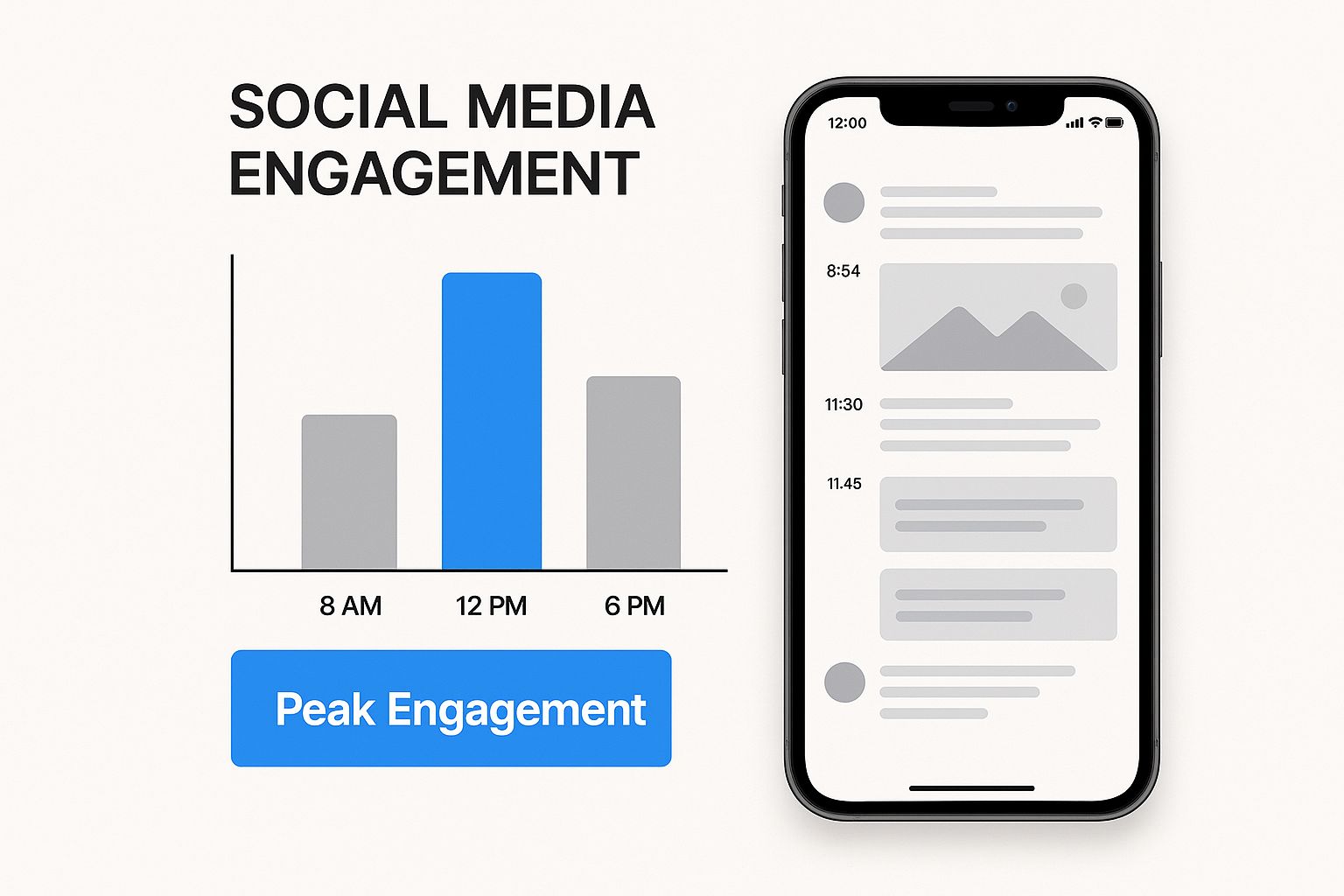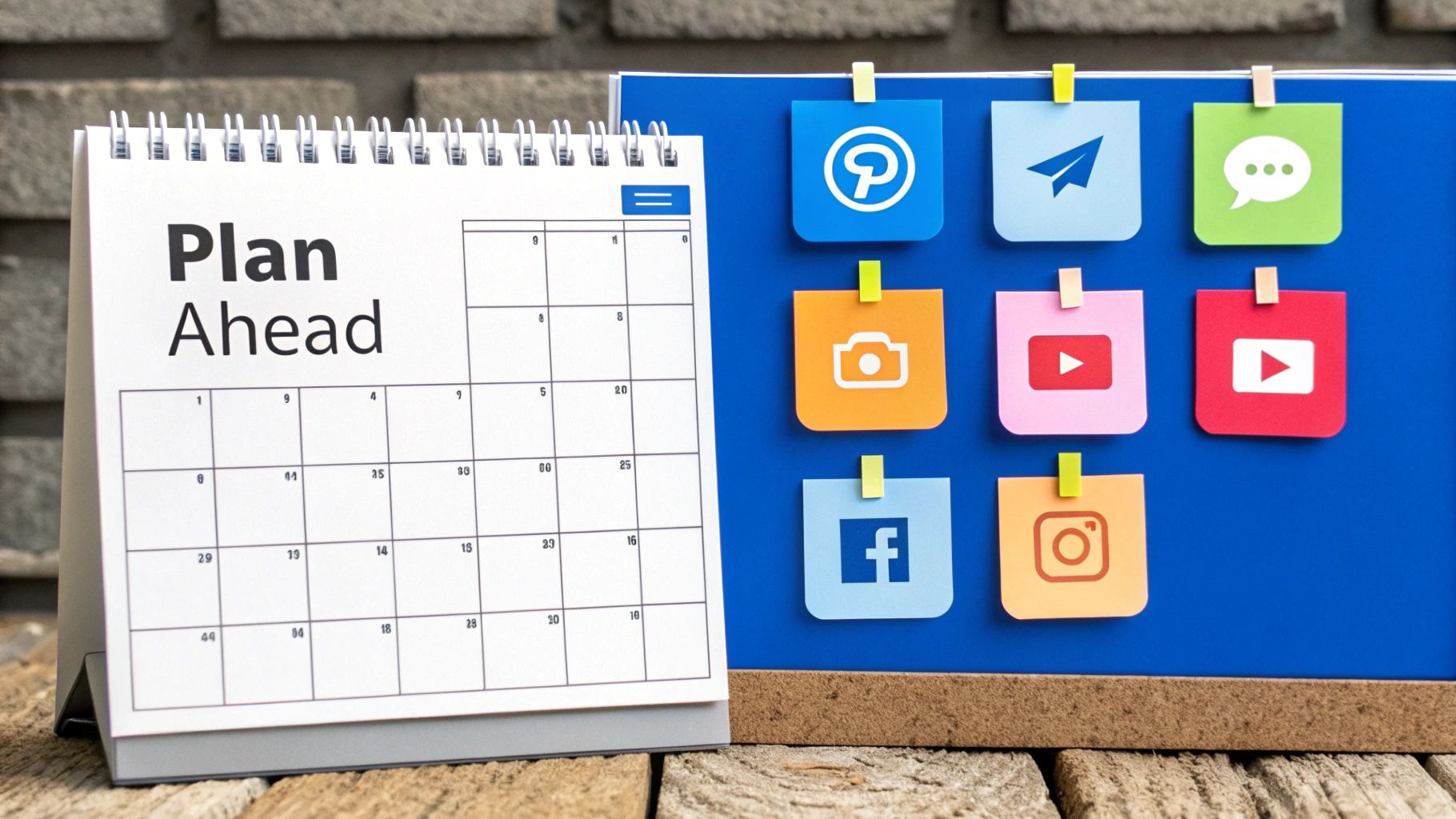Why Strategic Social Media Scheduling Transforms Results

Sporadic social media posting rarely delivers the results businesses want. It's similar to inconsistent plant watering – without regular care, it won't thrive. A haphazard social media presence also hinders growth and engagement. Strategic scheduling, however, builds the consistency that audiences and algorithms value. This consistent presence builds trust and brand recognition.
The Power of Predictability
Imagine your favorite store constantly changing its hours. Frustrating, right? Your audience feels the same when your posting schedule is erratic. Scheduling your social media posts creates a reliable content rhythm. This predictability reassures followers that you're actively engaged with your online community. Consistent posting also signals to algorithms that your content is valuable, which can boost visibility and reach.
Time is of the Essence
When you post matters just as much as how often you post. The goal isn't constant posting, but strategic posting. Data from 2025 suggests that the best times to post on social media are generally Mondays through Thursdays between 10 a.m. and 1 p.m. However, optimal times vary by platform. Understanding these nuances and tailoring your schedule accordingly can significantly improve engagement metrics. Tools like PostOnce can help you master social media scheduling.
From Reactive to Proactive: Batching and Quality
Scrambling for last-minute content often leads to burnout and low-quality posts. Scheduling lets you move from a reactive to a proactive content strategy. Batch creating content—dedicating blocks of time to planning and producing multiple posts at once—improves quality and frees up time for other tasks. Instead of rushing to create daily content, you can invest time in compelling visuals, engaging captions, and interacting with your audience. This strategic approach transforms not only your results but also your entire social media experience.
Mastering Posting Frequency Without Burning Out
The age-old question for every social media manager: how often should I post? Finding the right posting frequency is a balancing act. It requires maintaining visibility without overwhelming your audience. Over-posting can exhaust your team and dilute your message. Under-posting, however, risks losing relevance in the competitive social media landscape.
Finding Your Optimal Posting Cadence
There's no magic number for every brand. Your ideal posting frequency depends on a blend of factors:
-
Your Audience: How often do they want to hear from you? Analyze engagement patterns to understand their preferences. High engagement might indicate a tolerance for more frequent posts. Low engagement could signal the need to scale back.
-
Content Resources: Creating high-quality content takes time and effort. An overly ambitious posting schedule can lead to rushed, low-quality posts if you lack the resources to support it.
-
Business Goals: Are you focused on brand awareness, lead generation, or driving sales? Different goals might require different posting frequencies.
You might be interested in: How to master your social media presence.
The Quality vs. Quantity Dilemma
More posts don't necessarily equal more engagement. Prioritizing quality over quantity is essential for sustainable social media success. Think of it like a restaurant: serving a few exceptional dishes is better than offering a large menu of mediocre options. Focus on creating valuable content that resonates with your audience, even if it means posting less frequently.
Industry Benchmarks vs. Reality
Interestingly, there's often a disconnect between recommended posting frequencies and actual brand behavior. To illustrate this, let's look at some data. The following table compares expert recommendations with actual brand posting behavior and its impact on engagement.
Recommended vs. Actual Posting Frequency by Platform
Platform | Recommended Frequency | Actual Brand Behavior | Engagement Impact |
|---|---|---|---|
3 to 5 times per week | 9.3 posts per week | Potentially diluted engagement due to oversaturation | |
1 post per day | Varies widely, often higher than recommended | Can lead to decreased reach if engagement drops | |
Several times per day | Highly variable, often much higher | Requires highly engaging content to avoid being lost in the noise |
As the table shows, there are significant differences between recommendations and reality. For example, 2025 data from Hootsuite suggests posting on Instagram 3 to 5 times per week. However, businesses actually average 9.3 posts per week. Similar discrepancies exist on other platforms, indicating the pressure to maintain a constant presence. Find more detailed statistics here. This highlights the importance of finding a balance that works for your brand and audience, not just blindly following industry averages. Over-posting can lead to lower engagement, while aligning with audience preferences can improve results.
Developing a Sustainable Posting Strategy
To avoid burnout and maintain a consistent presence, consider these strategies:
-
Content Batching: Dedicate specific times to create multiple posts at once, allowing for more focused effort and improved quality.
-
Repurposing Content: Transform existing blog posts, videos, or infographics into bite-sized social media updates.
-
Using a Scheduling Tool: Platforms like PostOnce allow you to schedule social media posts in advance, freeing up time for other tasks and ensuring consistent posting.
-
Analyzing and Adjusting: Regularly review your social media performance and adjust your posting frequency based on engagement data.
By strategically scheduling your posts and focusing on providing value to your audience, you can maximize your impact without burning out your team. This balance between quality content, consistent posting, and strategic scheduling forms the foundation of a thriving social media presence.
Platform-Specific Timing Strategies That Actually Work

This infographic illustrates peak engagement times on social media, emphasizing the strategic importance of post timing. Understanding your audience's online habits is key to increasing your visibility and engagement. Let's examine the optimal timing for each platform.
Why Timing Matters on Social Media
Just as radio stations prioritize certain songs during peak commuting hours, social media platforms also experience periods of higher user activity. Different audiences engage with different platforms at different times. For instance, LinkedIn engagement tends to be higher during typical business hours.
This is because many professionals use the platform during their workday to stay updated on industry news, explore job opportunities, and connect with colleagues. On the other hand, platforms like Instagram and TikTok often see peak engagement during evenings and weekends when users have more free time. Recognizing these platform-specific trends is crucial for maximizing your content's reach.
Deciphering the Optimal Posting Windows
When exactly should you schedule your posts on each platform? There's no universal answer. The best times vary significantly across platforms. However, data analysis reveals some key trends that can guide your scheduling strategy.
For example, studies suggest the best time to post on Facebook is between 5 a.m. and 7 a.m. on weekdays. Instagram, conversely, performs well between 3 p.m. and 6 p.m. weekdays. LinkedIn sees the most engagement between 7 a.m. and 4 p.m. weekdays.
TikTok and YouTube are most effective between 4 p.m. and 7 p.m. and 3 p.m. to 5 p.m. weekdays, respectively. Finally, X (formerly Twitter) peaks between 8 a.m. and 10 a.m. weekdays. Further research on this topic can be found here. This data highlights the need for a tailored approach.
To summarize the best posting windows by platform, take a look at the table below:
Optimal Posting Times By Platform
A comprehensive breakdown of the best times to schedule posts on each major social media platform based on latest research.
Platform | Best Days | Peak Hours | Secondary Times | Worst Times to Post |
|---|---|---|---|---|
Weekdays | 5 a.m. - 7 a.m. | |||
Weekdays | 3 p.m. - 6 p.m. | |||
Weekdays | 7 a.m. - 4 p.m. | |||
TikTok | Weekdays | 4 p.m. - 7 p.m. | ||
YouTube | Weekdays | 3 p.m. - 5 p.m. | ||
X (Twitter) | Weekdays | 8 a.m. - 10 a.m. |
This table provides a helpful overview of ideal posting times, but remember to analyze your own data for more precise insights.
Tailoring Your Strategy for Each Platform
How can you turn these insights into a practical social media schedule? These times serve as a starting point, not a rigid framework. Tools like PostOnce can help you optimize your posting schedule across different platforms.
-
Experiment and Analyze: Start by scheduling content around the suggested peak times, then monitor your analytics closely. Which posts perform best? Does your data match the general recommendations? Don't hesitate to experiment.
-
Know Your Audience: General guidelines are helpful, but understanding your specific audience is paramount. Are they early birds or night owls? Use platform analytics to determine their peak activity periods.
-
Consider Content Type: The type of content you share also influences optimal timing. Informative content might perform well during business hours on LinkedIn, while entertaining content could see higher engagement on Instagram or TikTok during the evenings.
Mastering Time Zones for Global Reach
Managing time zones is crucial for businesses with a global audience. Reaching customers in Tokyo and New York simultaneously presents a unique scheduling challenge. Tools like PostOnce can simplify this process.
By scheduling posts according to different time zones, you ensure your content reaches the right audience at the optimal time, regardless of location. This maximizes visibility and encourages engagement across your entire global community.
Choosing the Right Tools to Schedule Social Media Posts
Maximizing efficiency and hitting your marketing targets relies heavily on selecting the right social media scheduling tools. It's not just a checklist of features; it's about how well the tool integrates with your team’s workflow and content needs. Deciding between free social media schedulers, paid options, and even the platforms' native schedulers is a key decision for any business.
Key Considerations When Choosing a Scheduler
Beyond the price, finding the ideal scheduling tool means assessing your team's structure and how collaborative the tool needs to be. Do you require complex approval workflows? Visual planning capabilities? Strong analytics? Specific platform integrations? These are all critical questions to consider. For example, if your focus is on Instagram, learning how to Add Link to Instagram Post can be invaluable.
Some platforms specialize in certain areas. Planable, for instance, is known for its team collaboration and approval workflows. Hootsuite provides robust analytics and social listening, while Buffer emphasizes simplicity and data-driven strategies. Choosing the right tool is about finding the perfect fit for your specific needs.
Exploring Different Tool Categories
The market offers a diverse selection of scheduling tools, each with its own strengths and weaknesses. Native schedulers, built into platforms like Facebook and LinkedIn, offer basic functionality. However, managing multiple accounts can become time-consuming. Free tools like PostOnce's free plan can be an excellent starting point, especially for those new to scheduling or working with a limited budget. They typically provide core scheduling features and basic analytics. Also, take a look at this helpful resource: How to master your social media scheduling.
Paid tools unlock more advanced features, such as bulk scheduling, content curation, detailed analytics, and team collaboration options. Platforms like Hootsuite and Sprout Social fall into this category, offering a complete suite of social media management features.
Integrating Scheduling Into Your Workflow
The most effective scheduling tools seamlessly blend into your existing content creation processes. They should enhance your team's efforts, not complicate them. Think about how a tool will impact your approval process. Does it streamline approvals or create bottlenecks?
Consider how the tool handles asset management and its potential integration with your analytics systems. A holistic view of social media performance is essential for informed decision-making. Successful teams see their scheduling tools as comprehensive workflow solutions, not just schedulers. They utilize them to plan content, collaborate, manage approvals, analyze results, and refine their strategies based on performance data. This comprehensive approach transforms social media scheduling from a routine task into a driver of growth and engagement.
Building a Content Calendar That Actually Works

Many content calendars start with great intentions, but often end up abandoned. This usually happens because they become too complex or fail to adapt to the dynamic world of social media. The key is creating a system that balances structure and flexibility—a calendar you can realistically maintain.
Structuring Your Calendar For Success
A successful content calendar serves as a roadmap, connecting your social media activities with your broader marketing objectives. It should offer a clear view of scheduled posts, letting you visualize your content mix and spot any gaps or overlaps. This helps maintain consistency and ensures balanced content distribution across platforms.
However, being too rigid can be a calendar's downfall. Flexibility is essential. Consider your calendar a guide, not a strict set of rules. This adaptability lets you leverage trending topics and react to events in real-time, keeping your content relevant. Explore options like social media automation tools to help streamline your workflow.
Content Categorization and Workflow
Effective categorization is fundamental to a functional content calendar. By categorizing your posts—by topic, campaign, or format—you can easily monitor your content balance. You might categorize posts as promotional, educational, or entertaining, for example. This creates a varied and engaging feed that appeals to different audience interests.
A streamlined approval process is equally important. Bottlenecks in approvals can disrupt even the best-planned calendar. Having clear approval stages and assigned approvers helps prevent delays and keeps your content on schedule. Consider using a collaborative platform for direct feedback and approvals within the calendar itself.
Asset Management and Long-Term Maintenance
A practical content calendar includes a system for asset management. This means a central location for all your visuals—images, videos, and graphics—easily accessible to your team. This prevents last-minute scrambles for visuals and ensures polished, visually appealing posts.
Ultimately, a good content calendar is one that's sustainable. It should be a living document, regularly reviewed and adjusted. Analyze your performance data and adapt your calendar accordingly. What content resonates most? What times see the most engagement? By continually refining your calendar based on data and feedback, you transform it from a static plan into a dynamic tool for ongoing social media success.
Advanced Scheduling Techniques the Pros Use
Beyond simply setting a posting schedule, social media professionals use advanced techniques to optimize content and boost its impact. These strategies go beyond the basics, exploring content recycling, A/B testing, and data-driven refinement.
Evergreen Content Recycling: Maximizing Value Without Fatigue
Think of your top-performing posts as valuable assets. Evergreen content—content that stays relevant and valuable over time—can be strategically recycled to reach new audiences and reinforce key messages. However, simply reposting the same content can lead to audience fatigue.
The trick is to repackage and refresh. For example, a blog post can become an infographic, a series of Tweets, or a short video. This keeps your content fresh while maximizing its lifespan. It's like a chef using core ingredients to create diverse dishes. This ensures maximum value without exhausting resources or boring your followers.
A/B Testing Your Scheduled Posts: Data-Driven Optimization
Just like optimizing a website landing page, A/B testing helps understand what resonates with your social media audience. Schedule post variations—different headlines, images, or calls to action—to identify the most effective combination. This removes the guesswork and allows data-driven refinement.
Imagine testing different email subject lines. The same principle applies to social media. By analyzing engagement metrics like likes, shares, and comments, you can identify top-performing content and adjust your strategy.
Performance Data and Timing Refinement: Adapting to Your Audience
Generic best-practice posting times are helpful starting points, but they don’t reveal your audience's specific engagement patterns. Continuously analyze performance data to understand when your followers are most active.
Do they engage more during lunch breaks or evenings? Are certain days better than others? Use this data to refine your scheduling, going beyond general recommendations. This data-driven approach allows you to adapt and improve results over time. It's like adjusting a ship's sails based on the wind – adapting your posting schedule maximizes your impact.
Managing Global Time Zones and Off-Hour Engagement
Maintaining engagement during off-hours or across multiple time zones doesn't require 24/7 staffing. Strategic scheduling tools, such as PostOnce, allow you to pre-schedule content for optimal times in different locations.
This lets you reach global audiences without weekend or late-night work. Consider it a virtual team member working constantly, ensuring your content reaches the right people at the right time, regardless of location.
Balancing Automation With Authenticity
While scheduling is powerful, authentic real-time engagement remains crucial. Schedule core content in advance, but dedicate time for interacting with your audience—responding to comments, answering questions, and participating in conversations.
This blend of planned content and spontaneous engagement creates a genuine connection. It’s like a well-orchestrated symphony, combining structure with the improvisational flair of a live performance. Streamline your social media presence and free up time for engaging with your audience. Start scheduling with PostOnce today!